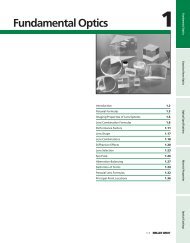Intel PXA250 and PXA210 Applications Processors
Intel PXA250 and PXA210 Applications Processors
Intel PXA250 and PXA210 Applications Processors
You also want an ePaper? Increase the reach of your titles
YUMPU automatically turns print PDFs into web optimized ePapers that Google loves.
Power <strong>and</strong> Clocking<br />
8.2 Electrical Specifications<br />
Table 8-2 provides the Absolute Maximum ratings for the applications processor. These parameters<br />
may not be exceeded or the part may be permanently damaged. Operation at Absolute Maximum<br />
Ratings is not guaranteed.<br />
Table 8-2. Absolute Maximum Ratings<br />
Symbol Description Min Max<br />
T S Storage Temperature -40° C 125° C<br />
V SS_O<br />
V CC_O<br />
Offset Voltage between any two VSS pins<br />
(VSS, VSSQ, VSSN)<br />
Offset Voltage between any of the following pins:<br />
VCCQ, VCCN<br />
-0.3 V 0.3 V<br />
-0.3 V 0.3 V<br />
V CC_HV<br />
Voltage Applied to High Voltage Supplies<br />
(VCCQ, VCCN)<br />
VSS-0.3 V<br />
VSS+4.0 V<br />
V CC_LV<br />
Voltage Applied to Low Voltage Supplies<br />
(VCC, PLL_VCC)<br />
VSS-0.3 V<br />
VSS+1.45 V<br />
V IP Voltage Applied to non-Supply pins except XTAL pins VSS-0.3 V<br />
max of<br />
VCCQ+0.3 V,<br />
VSS+4.0 V<br />
V IP_X<br />
Voltage Applied to XTAL pins<br />
(PXTAL, PEXTAL, TXTAL, TEXTAL)<br />
VSS-0.3 V<br />
max of<br />
VCC+0.3 V,<br />
VSS+1.45 V<br />
V ESD<br />
Maximum ESD stress voltage, Human Body Model;<br />
Any pin to any supply pin, either polarity, or<br />
Any pin to all non-supply pins together, either polarity.<br />
Three stresses maximum.<br />
2000 V<br />
I EOS Maximum DC Input Current (Electrical Overstress) for any non-supply pin 5mA<br />
8.3 Power Consumption Specifications<br />
Power consumption on any highly integrated device is extremely dependent on the operating<br />
voltage, external switching activity, <strong>and</strong> external loading (shown in Table 8-3, “Power<br />
Consumption Specifications” on page 8-3). Because power consumption on the applications<br />
processor is optimized, power varies based on which functions are being performed <strong>and</strong> by the data<br />
<strong>and</strong> frequency requirements of the module.<br />
The maximum power consumption specification is determined by all units running at their<br />
maximum: processor speed, voltage, <strong>and</strong> loading conditions. This method generates a conservative<br />
power consumption value; however, power supply <strong>and</strong> thermal management design requires the<br />
highest possible power consumption for robust design.The applications processor’s maximum<br />
power consumption is calculated using the following conditions:<br />
• All peripheral units operating at maximum frequency <strong>and</strong> size configuration<br />
• All I/O loads maximum (50pF for Memory interface, 100pF for peripherals)<br />
• Core operating at worst case power scenario (hit rates adjusted for worst power)<br />
• All voltages at maximum of range<br />
8-2 <strong>PXA250</strong> <strong>and</strong> <strong>PXA210</strong> <strong>Applications</strong> <strong>Processors</strong> Design Guide
















